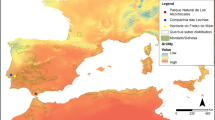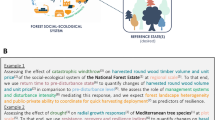Abstract
Forest landscape restoration is emerging as an effective approach to restore degraded forests for the provision of ecosystem services and to minimize trade-offs between conservation and rural livelihoods. Policy and institutional innovations in China illustrate the governance transformation of forest landscape restoration from state-controlled to polycentric governance. Based on a case study of the Ecological Forest Purchase Program in Yong’an municipality, China’s Fujian Province, this paper explores how such forest governance transformation has evolved and how it has shaped the outcomes of forest landscape restoration in terms of multi-dimensionality and actor configurations. Our analysis indicates that accommodating the participation of multiple actors and market-based instruments facilitate a smoother transition from state-centered to polycentric governance in forest landscape restoration. Governance transitions for forest landscape restoration must overcome a number of challenges including ensurance of a formal participation forum, fair participation, and a sustainable legislative and financial system to enhance long-term effectiveness.
Similar content being viewed by others
Notes
In China, an administrative village is a basic unit for community autonomy, however de facto, as well as for administrative purposes, often comprises a number of natural villages or villagers’ groups. A natural village may have one villagers’ group, but the larger ones may also be divided into several villagers’ groups (Zhong 2005).
1 USD = 8.2766 RMB in December 31, 2001; 1 USD = 6.4936 RMB in December 31, 2015.
The price of timber paid by EFPP differs according to tree species and size of timber. In 2015, the average price for Chinese fir (4 m × 12–18 cm) and Masson pine (4 m × 20–28 cm) were 1200 RMB/m3 and 1000 RMB/m3, respectively.
References
Agrawal A, Chhatre A, Hardin R (2008) Changing governance of the world’s forests. Science 320:1460–1462
Agrawal A, Wollenberg E, Persha L (2014) Governing agriculture-forest landscapes to achieve climate change mitigation. Glob Environ Chang 28:270–280
Andersson KP, Ostrom E (2008) Analyzing decentralized resource regimes from a polycentric perspective. Policy Sci 41(1):71–93
Arts B (2014) Assessing forest governance from a ‘Triple G’ perspective: government, governance, governmentality. Policy Econ 49:17–22
Aronson J, Brancalion HSP, Durigan G, Rodrigues RR, Engel LV, Tabarelli M, Torezan MDJ et al. (2011) What role should government regulation play in ecological restoration? Ongoing debate in Sao Paulo State, Brazil. Restor Ecol 19(6):690–695
Bushley B (2014) REDD+policy making in Nepal: toward state-centric, polycentric, or market-oriented governance? Ecol. Soc 19(3):34. https://doi.org/10.5751/ES-06853-190334
Bixler P (2014) From community forest management to polycentric governance: assessing evidence from the bottom up. Soc Natur Resour 27:155–169
Cashore B (2002) Legitimacy and the privatization of environmental governance: how non-state market-driven (NSMD) governance systems gain rule-making authority. Governance 15:503–529
Chazdon L (2008) Beyond deforestation: restoring forests and ecosystem services on degraded lands. Science 320:1458–1460
Chazdon L et al. (2016) When is a forest a forest? Forest concepts and definitions in the era of forest and landscape restoration. Ambio 45(5):1–13
Clement F (2010) Analysing decentralised natural resource governance: proposition for a “politicised” institutional analysis and development framework. Policy Sci 43(2):129–156
Deng H, Zheng P, Liu T, Liu X (2011) Forest ecosystem services and eco-compensation mechanisms in China. Environ Manag 48:1079–1085
FAO/RECOFTC (2016) Forest landscape restoration in Asia-Pacific forests. Bangkok, Thailand. http://www.fao.org/3/a-i5412e.pdf.Accessed 1 April 2017
Görg C (2007) Landscape governance: the “politics of scale” and the “natural” conditions of places. Geoforum 38(5):954–966
Guariguata M, Brancalion P (2014) Current challenges and perspectives for governing forest restoration. Forests 5(12):3022–3030
Howlett M, Rayner J, Tollefson C (2009) From government to governance in forest planning? Lessons from the case of the British Columbia Great Bear Rainforest initiative. For Policy Econ 11:383–391
Hobbs JR, Higgs E, Hall MC, Bridgewater P, Chapin III SF, Ellis CE, Ewel JJ et al. (2014) Managing the whole landscape: historical, hybrid, and novel ecosystems. Front Ecol En 12:557–564
He J (2014) Governing forest restoration: local case studies of sloping land conversion program in Southwest China. For Policy Econ 46:30–38
Jordan A, Wurzel RKW, Zito A (2003) “New” instruments of environmental governance: patterns and pathways of change. Environ Polit 12(1):1–24
Kooiman J (1999) Social-political governance: overview, reflections and design. Public Manag 1:67–92
Lamb D, Erskine DP, Parrotta AJ (2005) Restoration of degraded tropical forest landscapes. Science 310:1628–1632
Lemos MC, Agrawal A (2006) Environmental governance. Annu Rev Env Resour 31:297–325
Li WH (2004) Degradation and restoration of forest ecosystems in China. Ecol Manag 201:33–41
Li WH, Li F, Li SD, Liu M (2006) The status and prospect of forest ecological benefit compensation. J Nat Resour 21:677–688
Liu J, Li S, Ouyang Z, Christine T, Chen X (2008) Ecological and socioeconomic effects of China’s policies for ecosystem services. Proc Natl Acad Sci USA 105:9477–9482
Liu J, Inners J (2015) Participatory forest management in China: key challenges and ways forward. Int Rev 17:27–34
Mansourian S, Vallauri D, Dudley N (2005) Forest restoration in landscapes: beyond planting trees. Springer, New York
Miles B, Huberman M (1994) Qualitative data analysis. Sage Publications, Thousand Oaks
Minnemayer S, Laestadius L, Sizer N (2011) A world of opportunity for forest and landscape restoration. World Resource Institute, Washington DC
Mansourian S, Vallauri D (2014) Restoring forest landscapes: important lessons learnt. Environ Manag 53(2):241–251
Mansourian S, Aquino L, Erdmann TK, Pereira F (2014) A comparison of governance challenges in forest restoration in Paraguay’s privately-owned forests and Madagascar’s co-managed state forests. Forests 5:763–783
Mansourian S (2016) Understanding the relationship between governance and forest landscape restoration. Conserv Soc 14:267–278
Monroe AS, Butler WH (2016) Responding to a policy mandate to collaborate: structuring collaboration in the collaborative forest landscape restoration program. J Environ Plann Man 59(6):1–19
Newton AC et al. (2012) Forest landscape restoration in the drylands of Latin America. Ecol Soc 17(1):21 https://doi.org/10.5751/ES-04572-170121
Nagendra H, Ostrom E (2012) Polycentric governance of multifunctional forested landscapes. Int J Commons 6:104–133
Ostrom E, Janssen A, Anderies J (2007) Going beyond panaceas. Proc Natl Acad Sci USA 104:15176–15178
Ostrom E (2010) Polycentric system for coping with collective action and global environmental change. Glob Environ Chang 20:550–557
Reed J, Vianen VJ, Deakin LE, Barlow J, Sunderland T (2016) Integrated landscape approaches to managing social and environmental issues in the tropics: learning from the past to guide the future. Glob Chang Biol 22:2540–2554
Ros-Tonen MAF, Derkyi M, Insaidoo TFG (2014) From co-management to landscape governance: whither Ghana’s modified taungya system? Forests 5(12):2996–3021
Sayer J, Chokkalingam U, Poulsen J (2004) The restoration of forest biodiversity and ecological values. Ecol Manag 201:3–11
Sayer J, Sunderland T, Ghazoul J, Pfund JL, Meijaard E, Venter M, Boedhihartono AK et al. (2013) Ten principles for a landscape approach to reconciling agriculture, conservation, and other competing land uses. Proc Natl Acad Sci USA 110:8349–8356
Treib O, Bähr H, Falkner G (2007) Modes of governance: towards a conceptual clarification. J Eur Public Po 14(1):1–20
Thompson C, Baruah M, Carr E (2011) Seeing REDD+as a project of environmental governance. Environ Sci Policy 14:100–110
Van Oosten C, Gunarso P, Koesoetjahjo I, Wiersum F (2014) Governing forest landscape restoration: cases from Indonesia. Forests 5:1143–1162
Wunder S (2005) Payments for environmental services: some nuts and bolts. Center for International Forestry Research, Bogor Indonesia
Xu J, Yin R, Li Z, Liu C (2006) China’s ecological rehabilitation: unprecedented efforts, dramatic impacts, and requisite policies. Ecol Econ 57:595–607
Xu J (2012) China’s new forests aren’t as green as they seem. Nature 477:371
Zhong Y (2005) New institution building or muddling through in the Chinese countryside. In: Chen W, Zhong Y (eds) Leadership in a changing China. Palgrave Macmillan Ltd, New York, p 81–103
Acknowledgements
The authors would like to thank James Reed (Centre for International Forestry Research) and Mirjam Ros-Tonen (University of Amsterdam) for editorial support. This research was supported by the projects of “Development intervention, natural resources management, and rural transformation from the perspective of actor-oriented approaches” funded by Renmin University of China, and the project of “Study on local forest governance transformation from a decentralization perspective” funded by the National Natural Science Foundation of China.
Author information
Authors and Affiliations
Corresponding author
Ethics declarations
Conflict of interest
The authors declare that they have no conflict of interest.
Rights and permissions
About this article
Cite this article
Long, H., Liu, J., Tu, C. et al. From State-controlled to Polycentric Governance in Forest Landscape Restoration: The Case of the Ecological Forest Purchase Program in Yong’an Municipality of China. Environmental Management 62, 58–69 (2018). https://doi.org/10.1007/s00267-017-0972-7
Received:
Accepted:
Published:
Issue Date:
DOI: https://doi.org/10.1007/s00267-017-0972-7




